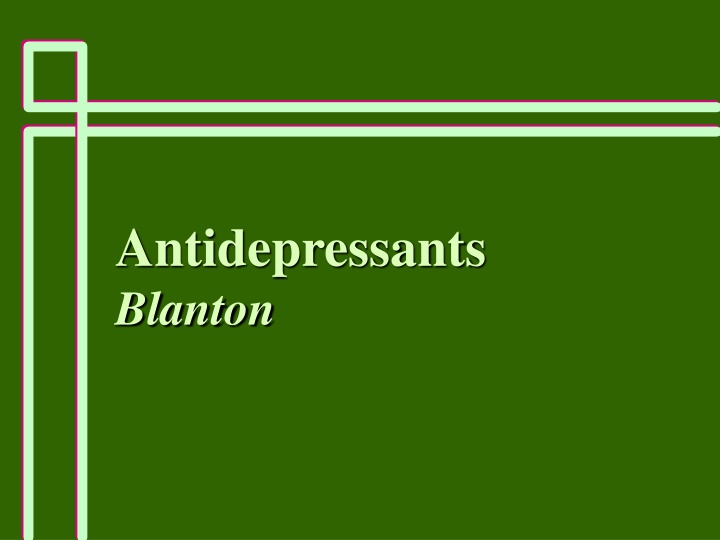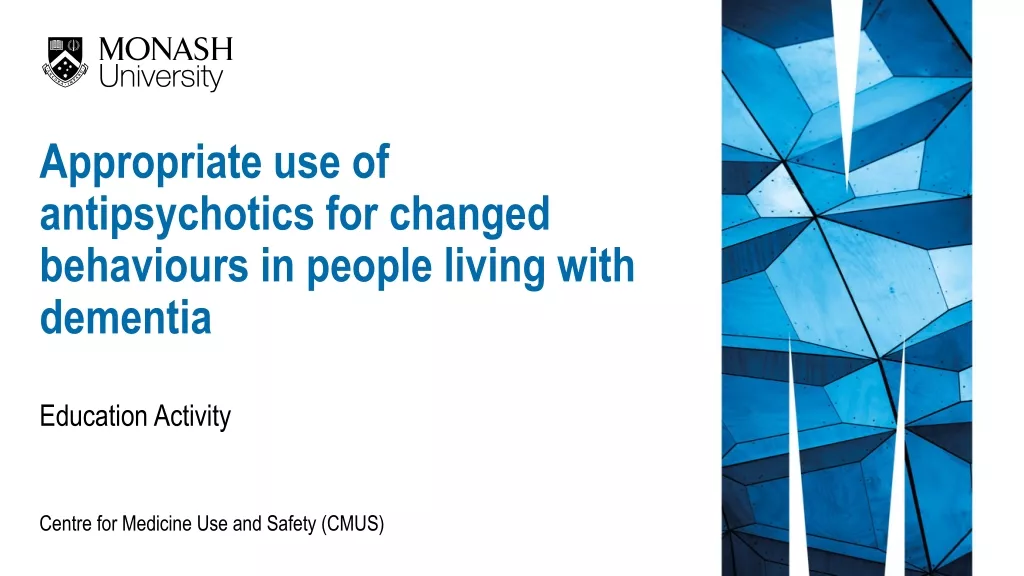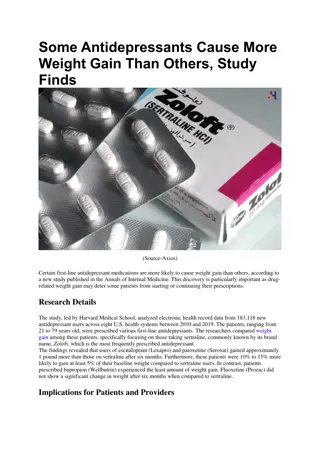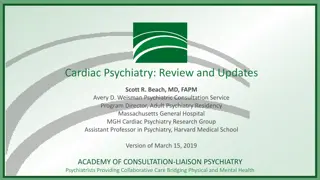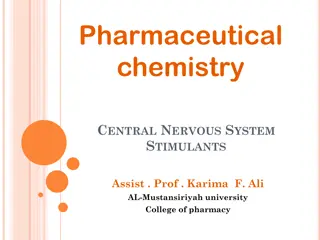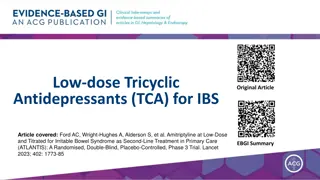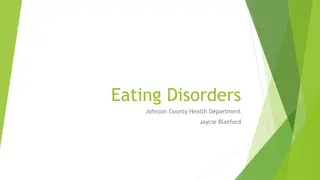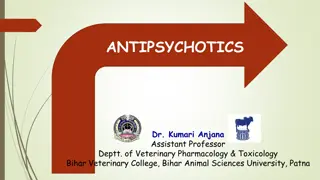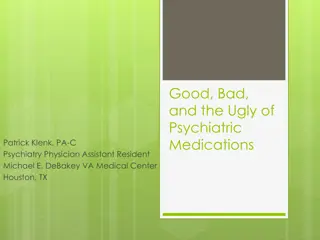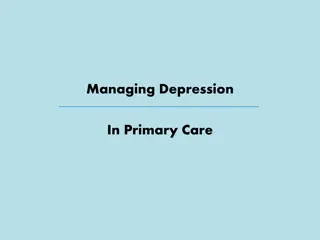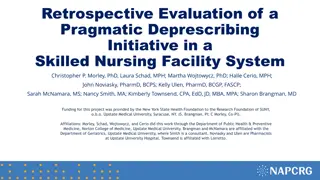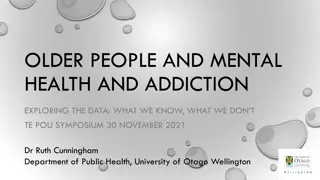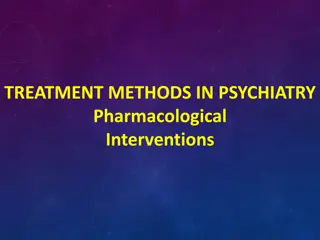Antidepressants
Discover the transformative journey with AntidepressantsBlanton as a powerful tool for improving mental health. Unravel the potential benefits, considerations, and insights into enhancing your well-being using this resource. Dive into a holistic approach to mental wellness and explore how AntidepressantsBlanton can be a supportive element in your self-care routine.
Download Presentation

Please find below an Image/Link to download the presentation.
The content on the website is provided AS IS for your information and personal use only. It may not be sold, licensed, or shared on other websites without obtaining consent from the author.If you encounter any issues during the download, it is possible that the publisher has removed the file from their server.
You are allowed to download the files provided on this website for personal or commercial use, subject to the condition that they are used lawfully. All files are the property of their respective owners.
The content on the website is provided AS IS for your information and personal use only. It may not be sold, licensed, or shared on other websites without obtaining consent from the author.
E N D
Presentation Transcript
Antidepressants Blanton
Affective Disorders SSRI s (fluoxetine) and SNRI s (venlaflaxine) are first line treatment for most anxiety disorders Major (Unipolar) Depression Dysthymia (Persistent Depressive Disorder) Bipolar Affective Disorder
Major (Unipolar) Depression Two weeks or more of: -depressed mood -anhedonia -changes in appetite/sleep -psychomotor agitation/retardation -decreased concentration -thoughts of death/suicide
Dysthymia (Persistent Depressive Disorder) Persistent (2 + years) of: -depressed mood -poor appetite/overeating -insomnia/hypersomnia -low energy, fatigue -poor self esteem -poor concentration -hopelessness
Mixed Disorder Baseline of Dysthymia with intermittent bouts of major depression
Treatment: Depression Pharmacological: Focus today 1.Psychological- Counseling, CBT! 2. Electroconvulsive Therapy (ECT) -Efficacy 80-90% -minimal side-effects: temporary retrograde amnesia 3. Transcranial Magnetic Stimulation (TMS)
Bipolar Disorder Intermittent bouts of depression with mania or hypomania Subtypes of bipolar disorder Strong hereditary component Depressive Phase: Varying degrees of depressed mood
Bipolar Disorder Mania Inflated Self Esteem, decreased need for sleep, very talkative, flight of ideas, distractible,psychomotor agitation, excessive preoccupation with pleasurable activities
Bipolar Disorder Mania Stages I-III: worse symptoms as number increases, see panic, hallu- cinations, looseness of association in Stage III Hypomania Milder Manic Symptoms
Bipolar Disorder Comorbid Psychiatric Disorders Substance Abuse Obsessive Compulsive Disorder Panic Disorder Bulimia
Treatment Unipolar Depression/ Dysthymia Similar Pharmacological Treatment
Depression- Treatment MAO Inhibitors- 1st Generation: increase of monoamines in synapse Tranylcypromine- irreversible inhibitor of MAO-A and B Uncommon Use- Side Effects Drug Interactions
Depression- Treatment Tricyclic Antidepressants: 2nd Generation Inhibition of NE, 5-HT, DA Transporters Mechanism of Action:Time delay in therapeutic action, neuroadaptive processes are involved.
Tricyclic Antidepressants Range of NE vs. 5-HT pump selectivity Tertiary Amines: relatively equal Secondary Amines: NE > 5-HT Selectivity
Tricyclic Antidepressants Imipramine--> Desipramine Amitriptylene--> Nortriptylene Parent Drug + Active Metabolite if tertiary amine is given
Tricyclic Antidepressants Side Effects Sedation: H1-R blockade? Anticholinergic: M-R blockade dry mouth, blurred vision urinary retention/ileus/constipation sexual dysfunction delirium/confusion precipitation of glaucoma
Tricyclic Antidepressants Side Effects: Cardiovascular Vascular: 1 blockade orthostatic hypotension Cardiac: quinidine-like effects concentration dependent T wave flattening or inversion myocardial depression arrhythmias (high conc.)
Tricyclic Antidepressants Drug Interactions Inhibition of P450 Enzymes Reduction of AntihypertensiveActions Reduction of Seizure Threshold Additive Sedative Effects with Alcohol and other Depressants Enhancement of Anticholinergics
Tricyclic Antidepressants Toxicity/Overdose Narrow therapeutic window Restrict Rx amount Overdose may result in: Hypotension, shock, renal failure Grand mal seizures Hyperpyrexia Conduction disturbances--> Arrhythmias
Tricyclic Antidepressants Toxicity/Overdose Supportive Measures respiratory, renal, cardiac Physostigmine Gastric Lavage Cooling Fluid Expansion
Tricyclic Antidepressants Other Uses Catalepsy (Narcolepsy) OCD Chronic Pain (Migraine) Panic Disorder Post-traumatic Stress Disorder Enuresis ADHD Eating Disorders
Depression- Treatment 3rd Generation Antidepressants Miscellaneous Drugs/Atypical Antidepressants Heterocyclics Trazadone Bupropion Serotonin Selective Reuptake Inhibitors (SSRIs)
Misc. Antidepressants/ Atypical Antidepressants Heterocyclics- Amoxipine- nonselective Maprotiline- NE selective Trazodone (Oleptro)-5-HT selective atypical , sedating no antichol. actions Bupropion- DA selective smoking cessation, ADHD
SSRIs Revolution in the treatment of depression: Safer! Less side effects: No Effects on Cholinergic, Histamine, or -adrenergic Receptors Fluoxetine- Most prescribed antidepressant
Fluoxetine (Prozac) Major depression, OCD, bulimia,PMS, panic disorder Side Effects: Headache, Anxiety,Insomnia, Drowsiness Tremor, Restlessness,Sexual Dysfunction N, D, Anorexia
Side-Effects of SSRIs 1. FDA Block Box Warning (2004): -weak but significant statistical link between SSRI s and increased risk for suicide in adolescents. 2. Serotonin Syndrome:SSRI s interaction with MAO inhibitors, altered mental status, fever, agitation, tremor, etc.
Sertaline (Zoloft) Major Depression, OCD, PanicDisorder Side Effects: N, D, Dyspepsia Dizziness, Insomnia Sexual Dysfunction
Paroxetine (Paxil) Major Depression, OCD,Panic Disorder June 28, 2013- FDA approved use of paroxetine (Brisdelle) for menopausal hot flashes (first non-hormonal treatment) Side Effects: N, D, Insomnia, Headache Sexual Dysfunction
Other SSRIs and SNRIs Citalopram (Celexa): racemic Mixture (2011 FDA warning that Celexa (citalopram) should not be used in doses greater than 40 mg per day because it can cause abnormal electrical activity in the heart) Escitalopram (Lexapro): S-enantiomer of Citalopram, (100 X more potent) ..Other SNRI s: Venlafaxine (Effexor), Duloxetine (Cymbalta)
How to choose an antidepressant? -History of prior drug response -Safety -Side Effect Profile -Compliance -Expense -Mechanism of Action
Bipolar Disorder Lithium Acute Mania Prophylaxis (70% respond) Side Effects: Memory problems, weight gain, tremor, poluria, drowsiness Hypothyroidism Cardiac Effects
Bipolar Disorder -Valproate (anticonvulsant) -Carbamazepine (anticonvulsant) -Lamotrignine (anticonvulsant) -Haloperidol (antipyschotic) -Add-on agents, aripazole (Abilify), atypical antipyschotic to help manage mania
Study Guide Learning Objectives in HO (know drugs listed in lecture script and ppt) FIRST AID BASIC SCIENCES 2nd Edition Chapter 6, pp 520-531; Chapter 7
